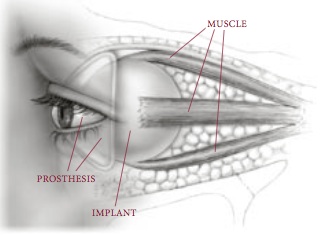Enucleation & Evisceration

ENUCLEATION
Enucleation and evisceration are terms that refer to surgery to remove the eye from the orbit. When the entire eye (with the exception of the muscles) is removed it is termed enucleation. The eye is replaced by a spherical implant. This implant is sometimes wrapped in donor sclera. The external eye muscles are left behind and sometimes are attached to the implant affording it mobility. The implant is usually made up of hydroxyapatite, silicone, acrylic, medpor or dermis fat graft. The type of implant varies depending on a number of circumstances and the materials vary depending on availability and new technologies. The implant remains permanently and a prosthesis is fitted 6 to 8 weeks later by an ocularist. See www.artificialeye.com or www.ericksoneyes.com for more information concerning the prosthesis.
EVISCERATION
This term is used to describe surgery when only the contents of the eye (iris, lens, vitreous, retina, choroid) are removed. This leaves behind a pocket of sclera. An implant as described above is placed in that pocket. The sclera is still attached to the external eye muscles so the implant generally has very good movement. The implant remains permanently and a prosthesis is fitted 6 to 8 weeks later as with enucleation.
